Cockatoo
| Cockatoos | ||||||||||
|---|---|---|---|---|---|---|---|---|---|---|
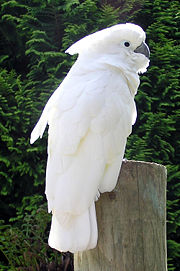 Umbrella Cockatoo
|
||||||||||
| Scientific classification | ||||||||||
|
||||||||||
| Subfamily | ||||||||||
|
Microglossinae |
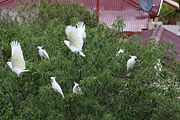
A cockatoo is any of the 20 bird species belonging to the family Cacatuidae. Along with the Psittacidae family (the true parrots), they make up the order Psittaciformes. The name cockatoo originated from the Malay name for these birds, kaka(k)tua (either from kaka "parrot" + tuwah, or "older sister" from kakak "sister" + tua, "old").
Cockatoos share many features with other parrots including the characteristic curved beak shape and a zygodactyl foot, with two forward toes and two backwards toes. They differ, however in a number of characteristics, including the often spectacular movable headcrest, the presence of a gall bladder and some other anatomical details, and their lack of the Dyck texture feather composition which causes the bright blues and greens seen in true parrots. Also Cockatoo species are, on average, larger than the average size of true parrots; however, the cockatiel, the smallest Cockatoo, is a small bird, and some of the largest parrots including the Hyacinth Macaw (the longest parrot) and the flightless Kakapo (the heaviest parrot), are true parrots. Placement of the cockatoos as a separate family is fairly undisputed, but it is not resolved whether or not other living lineages of parrots (such as the lories and lorikeets) are as distinct as they are.
Cockatoos have a much more restricted range than the true parrots, occurring naturally only in Australia and nearby islands. Eleven of the 21 species exist in the wild only in Australia, while seven species occur in Indonesia, New Guinea, and other south Pacific islands. Three species occur in both New Guinea and Australia.
Contents |
Cockatoos as endangered or vulnerable species
All species of cockatoo are protected by the Convention on International Trade in Endangered Species of Wild Fauna and Flora (also known as CITES), which makes the import, export and trade in all wild-caught parrots and cockatoos illegal.
The following cockatoo species are protected on the CITES appendix 1 list of endangered species.
- Goffin's cockatoo, Cacatua goffiniana
- Red-vented Cockatoo, Cacatua haematuropygia
- Moluccan Cockatoo, Cacatua moluccensis
- Yellow-crested Cockatoo, Cacatua sulphurea (includes the subspecies Citron-crested Cockatoo, Cacatua sulphurea citrinocristata)
- Palm Cockatoo, Probosciger aterrimus
All of the other cockatoo species are protected on the CITES appendix 2 list of vulnerable species. However, some species of Australian cockatoos including corellas and galahs, have large populations and are sometimes killed as crop pests.
Systematics and evolution
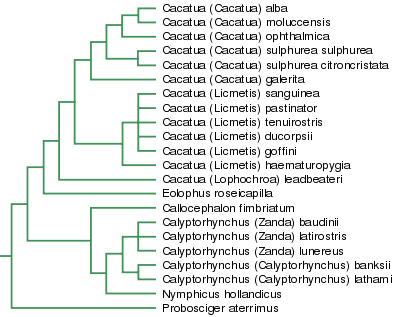
[not good - definitely need correct branch lengths and support values here. Astuti's data contradicts position of Nymphicus.]
Brown & Toft (1999) reviewed the existing evidence and additional mitochondrial 12S rRNA sequence data to arrive at a well-supported phylogeny of the cockatoos. They could distinguish 3 subfamilies:
- The all-black Palm Cockatoo represents distinct lineage that diverged early; it was previously sometimes grouped with the other black species but this is incorrect.
- The dark cockatoos; sexually dichromatic species which have ample melanin in their plumage and some red, yellow or orange on wing, tail and face, barred feathers on wing, tail and/or body as well as contrasting ear area spotting in females, while males have the corresponding feathers unbarred and may lack the ear spotting. This group includes the remaining black cockatoos, the Gang-gang Cockatoo and, interestingly, the cockatiel which had previously been placed in a subfamily of its own (Nymphicinae) or even as a broad-tailed parrot.
- The remaining species, which are all hypomelanistic and not sexually dimorphic.
The genera Calyptorhynchus and Cacatua can be further resolved into two subgenera each, and in the latter case as a distinct third lineage the white-and-pink Major Mitchell's Cockatoo, which is intermediate in coloration between the grey-and-pink Galah and the white Cacatua. It is best recognized as a monotypic genus Lophocroa. Indeed, pending further research, all subgenera could conceivably be raised to genus rank.
Intron 7 of nuclear β-fibrinogen sequence data suggests that the Microglossinae may have diverged later, and that the cockatiel might be distinct enough to warrant recognition of the Nymphicinae (Astuti, 2004?), but in other aspects agrees with the rRNA and newly-interpreted morphological data. However, a recent much more extensive study[1] using 5 different gene sequences confirmed the study of Brown & Toft (1999)
The fossil record of cockatoos is even more limited than that of parrots in general, with only one truly ancient cockatoo fossil known: A species of Cacatua, most probably subgenus Licmetis, was found in Early Miocene (16-23 mya) deposits of Riversleigh, Australia (Boles, 1993). In Melanesia, subfossil bones of Cacatua species which apparently did not survive early human settlement were found on New Caledonia and New Ireland. The bearing of these fossils on cockatoo evolution and phylogeny is fairly limited, except that the Riversleigh fossil allows some tentative dating of the divergence of subfamilies.
Family Cacatuidae
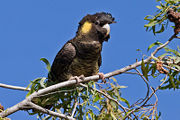
- Subfamily Microglossinae
- Genus Probosciger
- Palm Cockatoo, Probosciger aterrimus
- Genus Probosciger
- Subfamily Calyptorhynchinae - dark cockatoos
- Genus Callocephalon
- Gang-gang Cockatoo, Callocephalon fimbriatum
- Genus Nymphicus (tentatively placed here)
- Cockatiel, Nymphicus hollandicus
- Genus Calyptorhynchus
- Subgenus Calyptorhynchus - black-and-red cockatoos
- Red-tailed Black Cockatoo, Calyptorhynchus (Calyptorhynchus) banksii
- Glossy Black Cockatoo, Calyptorhynchus (Calyptorhynchus) lathami
- Subgenus Zanda - black-and-yellow/white cockatoos
- Yellow-tailed Black Cockatoo, Calyptorhynchus (Zanda) funereus
- Short-billed Black Cockatoo, Calyptorhynchus (Zanda) latirostris
- Long-billed Black Cockatoo, Calyptorhynchus (Zanda) baudinii
- Subgenus Calyptorhynchus - black-and-red cockatoos
- Genus Callocephalon
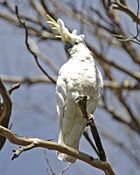
- Subfamily Cacatuinae - white cockatoos
- Genus Eolophus
- Galah, Eolophus roseicapilla
- Genus Cacatua
- Subgenus Lophocroa
- Major Mitchell's Cockatoo (aka Leadbeater's Cockatoo), Cacatua (Lophocroa) leadbeateri (Vigors, 1831)
- Major Mitchell's Cockatoo (aka Leadbeater's Cockatoo), Cacatua (Lophocroa) leadbeateri leadbeateri (Vigors, 1831)
- Western Major Mitchell's Cockatoo (aka Leadbeater's Cockatoo), Cacatua (Lophocroa) leadbeateri mollis (Mathews, 1912)
- Major Mitchell's Cockatoo (aka Leadbeater's Cockatoo), Cacatua (Lophocroa) leadbeateri (Vigors, 1831)
- Subgenus Cacatua - true white cockatoos
- Umbrella Cockatoo, Cacatua (Cacatua) alba (Müller, 1776)
- Sulphur-crested Cockatoo, Cacatua (Cacatua) galerita (Latham, 1790)
- Eleonora Cockatoo, Cacatua (Cacatua) galerita eleonora (Finsch, 1863)
- Fitzroy Cockatoo, Cacatua (Cacatua) galerita fitzroyi (Mathews, 1912)
- Greater Sulphur-crested Cockatoo, Cacatua (Cacatua) galerita galerita (Latham, 1790)
- Triton Cockatoo, Cacatua (Cacatua) galerita triton (Temminck, 1849)
- Moluccan Cockatoo (aka Salmon-crested Cockatoo), Cacatua (Cacatua) moluccensis (Gmelin, 1788)
- Blue-eyed Cockatoo, Cacatua (Cacatua) ophthalmica (Sclater, 1864)
- Yellow-crested Cockatoo (aka Lesser Sulphur-crested Cockatoo), Cacatua (Cacatua) sulphurea (Gmelin, 1788)
- Abbott's Cockatoo, Cacatua (Cacatua) sulphurea abbotti (Oberholser, 1917)
- Citron-crested Cockatoo, Cacatua (Cacatua) sulphurea citrinocristata (Fraser, 1844)
- Djameana Middle Sulphur-crested Cockatoo, Cacatua sulphurea djampeana
- Occidental Lesser Sulphur-crested Cockatoo, Cacatua sulphurea occidentalis
- Timor Cockatoo, Cacatua (Cacatua) sulphurea parvula (Bonaparte, 1850)
- Yellow-crested Cockatoo (aka Lesser Sulphur-crested Cockatoo), Cacatua (Cacatua) sulphurea sulphurea (Gmelin, 1788)
- Subgenus Licmetis - corellas
- Ducorps' Cockatoo, Cacatua (Licmetis) ducorpsii (Pucheran, 1853)
- Goffin's Cockatoo (aka Tanimbar Corella), Cacatua (Licmetis) goffiniana (Finsch, 1863)
- Red-vented Cockatoo, Cacatua (Licmetis) haematuropygia (Müller, 1776)
- Western Corella, Cacatua (Licmetis) pastinator (Gould, 1841)
- Little Corella, Cacatua (Licmetis) sanguinea (Gould, 1843)
- Long-billed Corella, Cacatua (Licmetis) tenuirostris (Kuhl, 1820)
- Subgenus Lophocroa
- Genus Eolophus
Aviculture
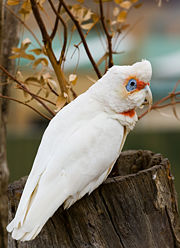
Cockatoos are very popular as pets, not only for their striking beauty but also for their intelligence and usually affectionate, outgoing, cuddly, and gentle personalities. Well-socialized cockatoos are often cuddly not only to their family but to strangers as well. Despite their high cost which typically ranges from $500-$2000 for the more commonly available species, cockatoos can make a wonderful pet for the right owner. Actual cost of the bird is not the only cost to consider. Cockatoos require a very large cage for their size, as they are very active and prone to mischief if allowed out unsupervised. Cockatoos also require an out of cage gym or perch and a steady supply of toys, branches, cardboard boxes, or other chewable items. The larger cockatoos in particular can be very destructive birds. Feeding your Cockatoo is also a consideration as they require a balanced diet of a good quality pellet food in addition to fresh fruits and vegetables. Most cockatoo species are very loud birds, though they naturally only vocalize for short periods of time twice a day.
Cockatoos are also not without their problems. In fact there are some who believe that the larger cockatoos should not be kept as house pets because of the challenges ownership can present. Cockatoos have been called the 'velcro' bird because they typically love to cuddle and spend time with their owner.[2] However, cockatoos can be extremely loud birds, and some owners may inadvertently teach them to scream for attention. A cockatoo should be rewarded when it is quiet and ignored when it screams excessively to reduce this problem. While pet cockatoos enjoy and need plenty of attention, they should never be spoiled by constant cuddling or petting. Cockatoos should be provided with a variety of interesting toys and encouraged to play by themselves from a young age to avoid them becoming overdependent on constant attention from the owners, which can be the cause of behavioral problems later on. Feather plucking is a problem some cockatoo owners may experience. It may be caused by several different factors such as lack of appropriate chewable toys, health problems, allergies, or boredom. Cockatoos which are spoiled with a great deal of attention when they are young and therefore do not learn to entertain themselves with toys are most likely to develop problems with plucking or screaming for attention. Some otherwise sweet adolescent male (and occasionally female) cockatoos may show aggression during the breeding season; cockatoos are capable of very damaging bites. Cockatoos are also very intelligent and mischief prone, and many become adept at escaping locked cages and may chew on furniture and woodwork in the house. Some owners recommend building an outdoor aviary into which a pet cockatoo may be put for a few hours a day in good weather; an aviary provides an excellent outlet for a cockatoo's energy that might otherwise be spent on undesirable behaviors. A cockatoo can make a challenging pet and has a long lifespan of up to 30-70 years depending upon species, so they require an owner committed to their care.
In general, the smaller cockatoo species such as Galahs and Goffin's Cockatoos are considered to be much easier to keep as pets than large cockatoos such as Moluccans. In Australia, where Galah cockatoos are extremely abundant and inexpensive, they are often considered to be good first birds.
Cockatoos are popular for use in trained bird shows. Many owners find they can be taught many tricks and husbandry behaviors, though cockatoos are generally less food motivated than other birds; some birds may be more motivated by a reward of petting or praise than of food. Cockatoos can often be trained to accept a parrot harness, enabling their owners to take them outdoors. Cockatoos have been used in animal-assisted therapy, generally in nursing homes.
Cockatiels
In contrast to the other cockatoos, the little cockatiel is non-destructive, less demanding, and gentle natured, though a pet cockatiel still requires daily attention and handling from its owners and veterinary care. Cockatiels are extremely popular as pets, and among the species most often recommended to new bird owners. Cockatiels have a typical maximum lifespan of 20 years but some have lived to over 30.
Popular culture
Cockatoos often have pronounced responses to musical sounds, and numerous videos exist showing the birds "dancing" to popular music, although it is not known if their musical perception is any different from that of other birds.
Gallery of Images depicting Cockatoos
Slang
In Australian slang or vernacular speech a person who is deputed to keep a look-out whilst colleagues undertake clandestine or illegal activities particularly such as organising illegal gambling may be referred to as a "cockatoo". Proprietors of small agricultural undertakings are frequently jocularly or slightly disparagingly referred to as a "cocky".[3]
References
- Astuti, Dwi (2004?): A phylogeny of cockatoos (Aves: Psittaciformes) inferred from DNA sequences of the seventh intron of nuclear β-fibrinogen gene. Doctoral work, Graduate School of Environmental Earth Science, Hokkaido University, Japan.
- Boles, W.E. (1993): A new cockatoo (Psittaciformes: Cacatuidae) from the Tertiary of Riversleigh, northwestern Queensland, and an evaluation of rostral characters in the systematics of parrots. Ibis 135: 8-18.
- Brown, D.M. & Toft, C.A. (1999): Molecular systematics and biogeography of the cockatoos (Psittaciformes: Cacatuidae). Auk 116(1): 141-157.
Notes
- ↑ Wright, T. F., Schirtzinger E. E., Matsumoto T., Eberhard J. R., Graves G. R., Sanchez J. J., Capelli S., Muller H., Scharpegge J., Chambers G. K. & Fleischer R. C. (2008). A Multilocus Molecular Phylogeny of the Parrots (Psittaciformes): Support for a Gondwanan Origin during the Cretaceous. Mol Biol Evol, 25, 2141-2156.
- ↑ Highfill, Carol, All You Need to Know about Cockatoos... and More: The Umbrella (White Crested) Cockatoos
- ↑ ABC NewsRadio: wordwatch, Cockatoo
External links
- Cockatoos of Hong Kong
- Cockatoo Heaven Species descriptions and articles
- Living With Companion Cockatoos
- MyToos.com - site explaining many of the responsibilities of cockatoo ownership